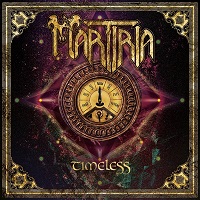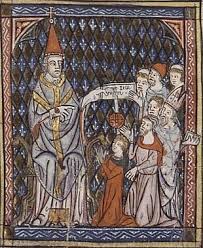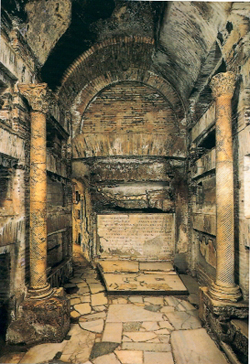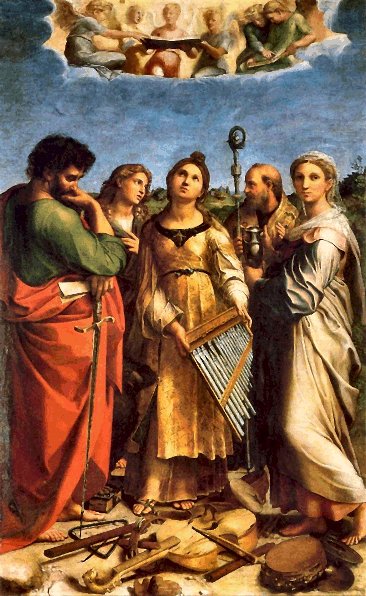|
|
|
|
Shortly about us
Martiria is an epic/doom metal
rock band formed back in the '80s and re-founded (after
a long pause) in 2002. Seven album published (last one R-Evolution, with ex Black Sabbath Vinny Appice - 2014).
The band was formed back in the '80s. At the beginning the
band was very much oriented towards Doom/Metal sounds such
as: early Candlemass and Black Sabbath. After releasing
just a few demos and featuring various musicians, in 1998
the members of the group decide to take a break for a while
in order to experience different projects. (continue) |
|
News and LIVE shows
Uh... it seems we have none planned right
now.
Why
don't you invite is in your local club?
mrc@martiria.com
(Booking info & more)
|

Info
& booking
info@martiria.com
|
Callistus
Wake
(Menarini - Capelli)
from the album "Roma
S.P.Q.R."
|
In the III century,
Christians had spreaded widely in Rome, but still
they were highly adversed by the public opinion, considering
their faith a dangerous superstition. After the first
persecution, started by Nero, many others had followed
and more than one Christian had found a violent death
in the hands of “justice”.
And strange indeed had to seem these men, who refused
violence and money, didn’t care about career
and power, that died under torture singing the name
of God and refused to burn their dead, swearing that
they were just asleep, waiting for the resurrection
of the souls and the bodies.
Roman laws forbid to bury bodies in town, therefore
they had to search for outer places where to bury
and mourn their martyrs and bishops. So they began
to dig into abandoned tuff rock caves, slowly turning
them into undergound temples, kilometers of passages,
alleys and crypts all devoted to prayer and memory,
in hope of future resurrection.
|
|
|
Deep down the earth,
Full of faith.
So proud, so scared
rest and wait.
While we wake
Grows the name
That Rome will carry ‘way.
Callistus (1)
digs,
Prepares his caves.(2)
Martyrs and Popes
Final homes.
Callistus digs
Removes the clay.
Then he rests and prays
We’ve a special guest tonight
Whose body here will lay.
(Oh) no, it isn’t right!
We’ve a special guest tonight,
For all she was a guide (3).
Light in the night.
Our children
Quietly
Sleep
West wing (4).
Small silent things.
Sometimes
I hear
Their steps,
I check
(but) all is quiet ’n’ dead.
And now she lies
On linen cloths
‘cause she didn’t
Break (her) oaths.
We mourn don’t weep
We know she sleeps.
It's a matter of faith.
Callistus digs
Raises his hat,
Cecily welcomes
With respect (5).
Callistus digs
Removes the clay
Then he rests and prays
Callistus is dead – and well he knows
Still there is too much to do
Dead or alive, he keeps on, goes.
Matter of faith, you know!
Wake and pray,
Do not go!
Inside the ground, down under Rome
Xantian marbles, rotten stones.
Thousands sleep, quiet ’n’ nameless
Heaven is two steps above,
You will soon
Cry for love. (6)
Cecily smiles
(And) closes her eyes.
Callistus digs again,
More room to claim.
For our wake is long
Dawn is far away.
(Menarini - Capelli
2012)
Ode to St.Cecilia
Henry
Purcell (1688)
|
|
(...) quod essent soliti stato
die ante lucem convenire carmenque Christo quasi deo
dicere secum in vicem seque sacramento non in scelus
aliquod obstringere, sed ne furta, ne latrocinia,
ne adulteria, committerent, ne fidem fallerent, ne
depositum appellati abnegarent: quibus peractis morem
sibi discedendi fuisse rursusque coeundi ad capiendum
cibum, promiscuum tamen et innoxium; (...) Quo magis
necessarium credidi ex duabus ancillis, quae ministrae
dicebantur, quid esset veri et per tormenta quaerere.
Nihil aliud inveni quam superstitionem pravam, immodicam. (8)
Plinius Traiano Imperatori Ep. 10.96
|
|
Notes
(1) Pope
Callixtus I (died 223), also called Callistus
I, was the bishop of Rome from c. 218 to his death in
223. He lived during the reigns of the Roman Emperors
Elagabalus
and Alexander
Severus. He was martyred for his Christian faith (being
thrown in a pit) and is venerated since as a saint by
the Catholic Church.
(2)
When callistus was a deacon of Rome, under the direction
of Pope
Zephyrinus, he directed the construction of a large
subterranean structure along the Appian
Way, just a few hundred meters after the Quo Vadis?
chapel, enlarging pre-existing early Christian hypogea.
This structure, known nowadays as The
Catacomb(s) of Callixtus
(also known as the Cemetery of Callixtus), is one among
the most important Catacombs of Rome, most notable for
containing the Crypt of the Popes (Italian: Capella
dei Papi), which once contained the tombs of sixteen popes
from the 2nd to 4th centuries and many Martyrs and early
christians.
After Constantine
Edict in 313, Christians could freely follow their
religion and places like the Catacombs of Callixtus began
to be venerated by pilgrims. After the IX century Barbaric
Invasions, they were abandoned and slowly totally forgotten.
(3) St.Cecilia,
Virgin and Martyr, AD 230. St.Cecila was a native of Rome,
and of good family, and educated in the principles and
perfect practice of the Christian religion. In her youth
she by vow consecrated her virginity to God, yet was compelled
by her parents to marry a nobleman named Valerian. Him
she converted to the faith, and soon after gained to the
same his brother Tiburtius. The men first suffered martyrdom,
being beheaded for the faith. St. Cecily finished her
glorious triumph some days after them. Their acts, which
are of very small authority, make them contemporary with
Pope Urban I., and consequently place their martyrdom
about the year 230, under Alexander Severus.
(Rev. Alban Butler (1711-73). Volume XI: November. The
Lives of the Saints. 1866.)
.jpg) Apparently
the executioner after the three "legal" strokes
didn't manage to kill her and left her agonizing in her
own blood with her head still connected to the body. Pope
Urban the I assisted to her death and had her translated
in the tomb of the bishops. The body was translated in
831 in Santa Cecilia in Trastevere. Inspected in 1599
they were still well conserved and a statue was sculpted
by Stefano
Maderno to show the exact position in which the body
was found. The same statue that can still be seen in the
church. Apparently
the executioner after the three "legal" strokes
didn't manage to kill her and left her agonizing in her
own blood with her head still connected to the body. Pope
Urban the I assisted to her death and had her translated
in the tomb of the bishops. The body was translated in
831 in Santa Cecilia in Trastevere. Inspected in 1599
they were still well conserved and a statue was sculpted
by Stefano
Maderno to show the exact position in which the body
was found. The same statue that can still be seen in the
church.
St. Cecila has become the protector of musician and she
is often depicted with musical instruments, but probably
this tradition comes from a mistaken interpretation of
the sentence: Cantantibus organis, Cecilia virgo
in corde suo soli Domino decantabat dicens: fiat Domine
cor meum et corpus meum inmaculatum ut non confundar -
While the instruments were singing, virgin Cecily was
singing in her heart for the Lord, saying: Lord, let my
body and my heart conserve their innocence so that I am
not confused. The "organibus" were most certainly
the torture instruments, and we can imagine how they
were singing... but since middle age this mistaken traduction
started a tradition that finally consecrated her has protector
of the musician.
Her feast day became an occasion for musical concerts
and festivals that occasioned well-known poems by John
Dryden (1631-1700) and Alexander
Pope (1688-1744), and music by Henry
Purcell (1659-1695) (Ode
to St. Cecilia), George
Frideric Handel (1685-1759) (Ode
for St. Cecilia's Day) and Benjamin
Britten (1913-1976), who was born on her feast day,
(Hymn
to St. Cecilia).
(4) In
the western wing of S.Callistus catacombs there are smaller
tombs probably used to bury children.
(5) Callistus
died in 222, Cecily in 230, but I liked to imagine that
his ghost keeps digging in the catacumbs, an old man minding
forever the bodies of those that lay there, waiting for
resurrection.
(6)
You may have noticed (or not) that the first letters of
the lines of this strophe, if read in sequence, form the
acronym IXTHYC (ichtùs) in greek alphabet,
that means "fish", but also: Iesùs
Christòs Theòu Uiòs Sotèr
(Jesus Christ Son of God the Saviour). The first Christians
lived in a pagan society that was totally hostile to them,
so they used to hide themselves under a complex symbology.
They used to mark tombs and catacombs with cryptic symbols
painted or engraved in marble. One of them was, indeed,
"the fish", IXTHYC in greek as explained above.
Others were "alpha" and "omega" (the
first and the last Greek letters, symbolizing the beginning
and the end), X (chi) and P (ro) Jesus monogram (first
two letters of Christos) or the "good" shepherd.
(7)
"Corpses shall not be buried nor burnt inside
the city walls."
Since this rule was clearly stated in the Law
of the Twelve Tables (Latin: Leges Duodecim Tabularum
or Duodecim Tabulae), early Christians had to found burial
places outside the city. They picked pre-existing structures
like stone caves or early Christian hypogea nearby the
main consular roads and enlarged them successively, according
to their growing population. The first place to be referred
to as catacombs was the system of underground tombs between
the 2nd and 3rd milestones of the Appian Way in Rome,
where the bodies of the apostles Peter and Paul, among
others, were said to have been buried. Catacombs where
used for the first centuries of the Christian Era and
then forgotten during the Middle Age, just to be rediscovered
in XVIII and XIX century by modern archeologists.
(8)(...)they had met
regularly before dawn on a certain day to chant verses
antiphonally amongst themselves in honor of Christ as
if to a god, and also to bind themselves with an oath,
not in a criminal conspiracy, but to abstain from fraud,
banditry, and adultery, to commit no breach of trust,
and not to renege on a deposit. After completing this
foolishness, it was their custom to disperse and reassemble
later to take food of an common and innocuous type (…)
. This made me decide it was all the more necessary to
extract the truth from two female slaves-whom they call
"ministers"-by means of torture. I found nothing
but a degenerate sort of superstition carried to immoderate
lengths.
From the "letter
regarding Christians" written around 112 by Pliny
the Younger (61-113) to imperator Traianus
(Trajan 53-117) while Pliny was the Roman governor
of Bithynia-Pontus
(now in modern Turkey). It's a quite famous letter because
its contents were, in the view of many historians, to
become the standard policy toward Christians for the rest
of the pagan era.
The rights of this song are exclusive
properties
of MARTIRIA and are protected by SIAE
The lyrics of the
album "Roma S.P.Q.R" have been written by Marco
R.Capelli,
if you want to know more about his activity as poet and
writer (and if you speak italian)
you can give a look
to this website: WWW.PROGETTOBABELE.IT
|
| |
| |
|













.jpg)